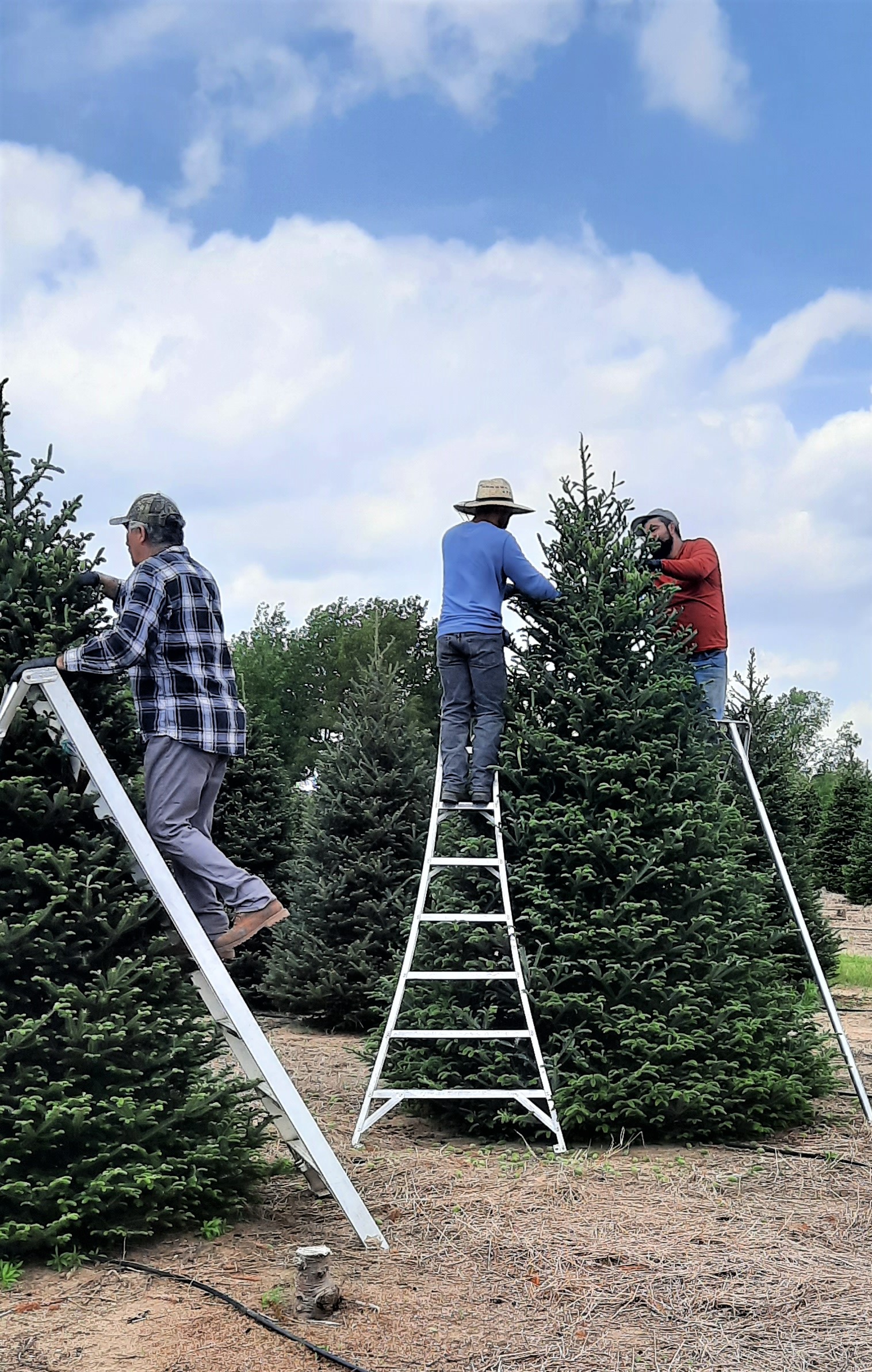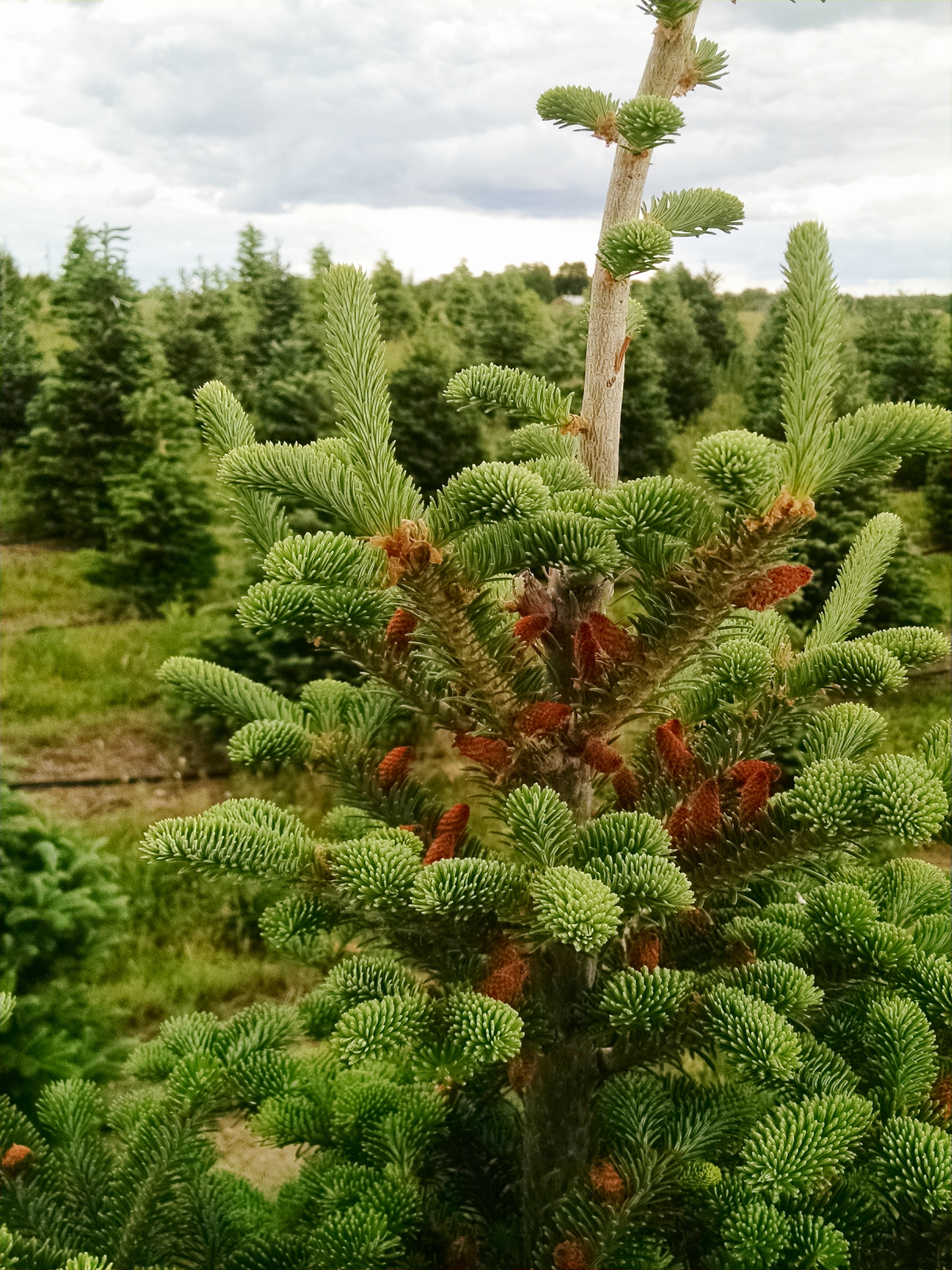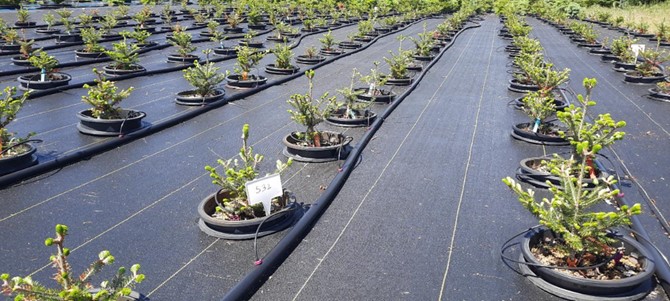The cone wars: How do we stop them?
Removing Fraser fir cones is a costly, labor-intensive practice, but recent research provides some new management options.

Fraser fir is among the most widely grown Christmas tree species in Michigan and the Midwest due to its excellent form, needle color, scent and superior needle retention. For growers, however, one downside to producing Fraser fir trees is excessive cone production (Photo 1). In fact, the largest labor expense many Christmas tree growers encounter in tree production is cone removal (Photo 2). In agricultural settings, Fraser fir Christmas trees start producing cones at a much earlier age than they do in natural stands in North Carolina, where the species is native. In plantations, cone production can begin three to five years after transplanting, and cone quantity increases as trees age.

Cones are problematic for several reasons. The first is that cones are photosynthetic sinks, diverting energy away from vegetative growth. This can greatly reduce tree quality by limiting top shoot growth, reducing bud density and creating vegetative holes in the upper tree canopy where high amounts of cones were formed. Cones also result in an aesthetic problem at harvest. Cones of fir trees, unlike pines or spruces, are not persistent and disintegrate in the fall. The remaining stalks left behind are undesirable to customers and can greatly reduce tree value (Photo 3).
Some fir species, such as Fraser fir and Korean fir, tend to produce large quantities of cones early in their life cycle. Most other fir species do not produce cones until trees are past the typical harvest age for Christmas trees. Individual Fraser fir trees can produce hundreds of cones per year and growers have reported over a thousand cones on a single tree.
Cone management strategies
Physical removal
Removing cones by hand is a common practice. The ease of removal changes as cones mature. Initially, cone removal is difficult and can often result in part of the cone breaking apart while a portion remains on the tree. As cones age, they become easier to remove and can be easily pushed off the tree. However, shortly thereafter the cones hold fast to the tree and require more force (twisting and pulling) to remove.
As mentioned previously, the cost involved with manually removing cones can be very high. Costs can vary widely due to many factors, such as number of cones per tree, tree height and tree density, but expenses of $1,000-plus per acre can occur.
Finally, as trees mature and grow taller, cone removal requires workers going up and down ladders to remove cones. This becomes a potential worker safety issue with employees working from ladders on uneven ground.
Chemical control
Research at Michigan State University (MSU) and at North Carolina State University has demonstrated that development of cones can be stopped using sprays of various formulations of pelargonic acid or citrus oil. The products are sold as burndown herbicides, including some marketed for organic production. When applied to fir cones in the time window between cone emergence and vegetative budbreak, products such as Scythe, Axxe or Avenger herbicides can provide 80-100% cone control when applied with backpack sprayers (Photo 4).

Be aware of the potential for phytotoxicity (tree injury), and sprays cannot be applied once vegetative budbreak has occurred. It is important to remember that products do not need to be applied to the entire tree or trees without cones, but can be targeted to cones specifically. Coverage is critical, as cones that do not receive spray contact will not be damaged and will continue to develop. Research performed over multiple years and at many grower-cooperator farms found the following results:
- A single application of a caustic product reduced cones by over 80%.
- Phytotoxicity was low across multiple farms when sprays were applied prior to vegetative budbreak.
- Several products showed good results (Scythe, Axxe and Avenger), with Scythe showing the best cone kill.
It is essential that applicators wear appropriate personal protective equipment (PPE) and avoid spray drift.
Preventing cone formation
Another way to reduce cones is to stop them from being produced by the tree. Cone formation is a complex process, but in part is controlled by environmental factors. Trees that experience stressful summer conditions (heat, drought) tend to produce more cones the following year than when they experience more moderate conditions. Growers have reported supplemental irrigation applied consistently over the course of the growing season reduced the number of cones the following year. Previous research by MSU contradicts those reports, with no change in cone production under various irrigation or mist cooling regiments. Future research is needed to determine potential causes of this discrepancy and what cultural practices growers can implement to limit cone formation.
Cone formation can also be affected by the application of plant growth regulators (PGRs). Gibberellic acid (GA) is a naturally occurring hormone in conifers involved with cone formation. Compounds that block GA pathways can reduce cone formation. MSU trials showed that soil applications of the GA-inhibitor paclobutrazol (trade name Cambistat) in the summer reduced cone formation the following years by up to 40%. Other observations following paclobutrazol application were an increase in bud density and a reduction in leader growth (30-40%). Paclobutrazol is persistent in the soil; a single application can reduce coning for three to four years. A limitation of managing cone formation with PGRs is that all trees need to be treated, whether they will produce cones or not.
Improved genetic stock
Within a tree species, some trees naturally produce fewer or no cones compared to other trees. Approximately 10 years ago, MSU researchers collected about 70 Fraser fir trees that were found to produce very few or no cones in tree plantations, relative to their peers. The trees were transplanted to a plot at the MSU Horticulture Teaching and Research Center (HTRC) to form an experimental delayed-coning seed orchard (Photo 5).
As the trees eventually began to produce cones, we made a series of seed collections from the orchard. Seedlings were grown by a cooperating nursery, Peterson’s Riverview Nursery, LLC, in Allegan, Michigan. Trees from the first collection from the seed orchard are now being grown in a trial at the MSU Horticulture Teaching and Research Center (Photo 6). The goals of this project are to observe these seedlings to determine whether they produce cones at an early age, and if they do not, to provide them as a potential genetic stock for continued tree improvement efforts and future tree plantations.

For management information and upcoming events, sign up to receive Michigan State University Extension’s Christmas Tree Production newsletter. For further information, visit MSU Extension's Christmas Trees website or contact Bill Lindberg at lindbe35@msu.edu.



 Print
Print Email
Email




